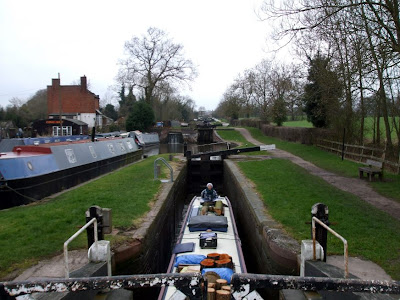Although in the case of the GU here, it does also describe the navigation.
Land and Water, BW’s contractors, are hard at work on the Lapworth flight. They are repairing sections of washed out bank and then dredging to improve the channel.
There’s a “soft edge” bank repair that is often used these days, especially on the non-towpath side. It’s quicker and cheaper than sheet piling, and gives a more natural look to the canal bank.
First the wash-damaged bank is tidied up….
Then a row of stakes is driven into the canal bed at regular intervals.
Then a plastic membrane is attached to the stakes.
Once this is secure the channel is dredged and the silt dumped behind the membrane, rebuilding the bank.
Eventually plants and grasses will colonise the fertile silt, stabilising the new edge.
The guys were hard up work just down from us too, emptying mud hoppers.
We came up to them shortly after moving off, and Rock’n’Roll kept running aground trying to get past until they moved two of the hoppers out of the way.
Dredging – right place, wrong time (for us, anyway).
The work they’re doing is certainly needed, the pounds are very shallow in places.
We got into the Lapworth flight at around 11:20, and made quick progress down the locks.
Fine cottage alongside Lock 8.
We only met one other boat in the flight, but reached the bottom at the Lapworth Link after about 2 hours 20 minutes.
The short arm between the Stratford and Warwick and Birmingham (later to become part of the Grand Union) canals was built in 1803, but initially boats heading north up the Stratford Canal and turning onto the W&B had to go up Lock 21, turn sharp right and then down Lock 20.
In the picture L20 is on the left, L21 on the right.
Someone then had the bright idea of cutting a short, narrow channel linking the levels below both of the locks, effectively making a short-cut.
The Lapworth Link, with a typical barrel-roofed Stratford Canal lock cottage alongside.
Heading down the Stratford and aiming for the GU we could have taken Lock 20, but we needed the services to be found in the basin below Lock 21, so we went that way, then turned around and went through the link.
Through the narrow passage of the link.
Come to think of it, we’ve never used Lock 20, even though we’ve come through this junction several times.
Out of the link and we turned left, back towards Birmingham. We’ll not be going all the way, though.
The south Stratford was in serious danger of total closure in the 1950’s. Although trade had stayed on the northern section as an alternative route into Birmingham, traffic had declined sharply on the southern bit from Lapworth to Stratford in the early 20C. Badly silted and with locks in dire need of repair, Warwickshire County Council applied for an abandonment order so they could rebuild a road bridge at Wilmcote at a lower level, effectively cutting the canal in two. The Stratford On Avon Canal Society (SONACS) was formed, and successfully opposed the application, The National Trust leased the southern section from British Waterways, and restoration was started. After 3 years of graft, often using volunteer labour, the Queen Mother officially opened the restored section. The date was 11th July 1964, just 6 years after the closure attempt. Lots more info on SONACS’s website here.
Back out onto the Grand Union, and the difference between the canals is immediately apparent. The main line up from Napton Junction was extensively improved in the 1930’s, broad locks replaced the earlier narrow ones and the waterway was widened and deepened.
Long wide straights on the Main Line.
We pushed on for about 3 miles, mooring up just past Bridge 70.
What’s up, never seen a boat before?
It’s been a cold but dry day. Not too bad for George and I, running up and down doing the locks, but I reckon the girls must have felt the chill on the back of the boats. Roll on summer….
If you’re in Redditch and looking for something to do next Saturday evening this might be worth a look. The books are certainly entertaining, anyway.
Locks 16, miles 4½







No comments:
Post a Comment